Korankei
(lit: Fragrant Storm Valley)
in Asuke-cho, Toyota C.
Asuke is a small town lying between low mountains in North-East of Aichi Pref.
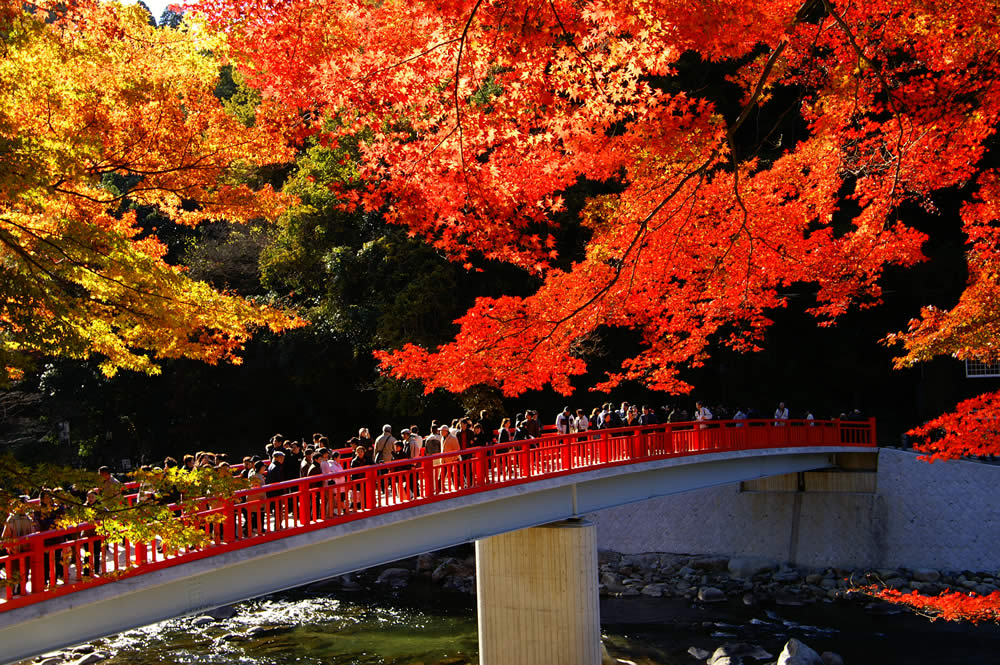
Korankei
(lit: Fragrant Storm Valley)
in Asuke-cho, Toyota C.
Asuke is a small town lying between low mountains in North-East of Aichi
Pref.

| November | May |
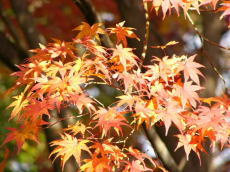 |
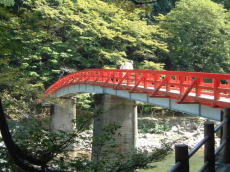 |
| Beautifully changed maple leaves |
Taigetsukyo (lit. waiting the moon appearance bridge) over the Tomoe River |
It is said that the best season of korankei is Autumn.
4,000 maple trees change their green leaves into red and yellow.
They hold "Korankei Momiji matsuri (Korankei maple Festival)"from
the beginning
to the end of November. Maple trees are illuminated from 5:00p.m. to 9:00p.m.
It is so beautiful and we can enjoy the trees aflame with red and yellow
leaves
in different way from the daytime.
Tea ceremonies, koto or drum performances, ceramics exhibition, Chin-don
parade etc.
are held during the Maple Festival.
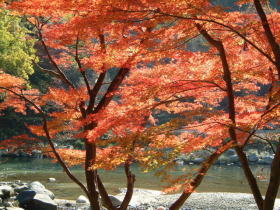 |
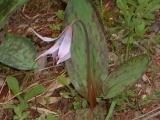 |
| Japanese dogtooth violet |
We enjoy a heavy growth of Japanese dogtooth violet in early spring (late
March) on the North-West hillside of Mt. Iimori .
In summer, we have a barbecue party on the river side of the Tomoe River,
enjoy fishing (you need permit from the fishermen's cooperative to fish)
and children play with water.
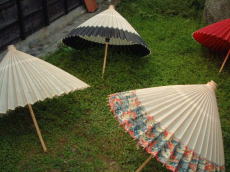 |
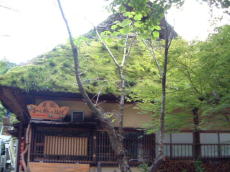 |
| Japanese umbrella made in Asuke | a roof covered with moss and plants |
![]()
Sanshu-Asuke Yashiki
(traditional Japanese farming village)
There are a farm house, a store house, a cow house, a water mill, handcraft
center, etc.
They show a traditional Japanese life in mountainside.
Recently we Japanese can have convenient and easy life even in the country.
But they still keep it and lead us nostalgie.
entrance fee: 500yen
business hour: 9:00a.m.-5:00p.m.(tickets are sold until 4:30p.m.)
closed: Thursday (if thursday falls on a national holiday, friday will
be closed), Dec. 25 totJan. 2
Open everyday April 29-May 5, and month of November.
(The hours of operation and days may change without notice.)
TEL: 0565-62-1188
| Information copied from a leaflet of Sanshu Asuke Yashiki | |
| Farm house | This building presents the traditional Japanese house with a thatched roof
and big beams. Smoke coming from cooking rice in a pot, steam coming from cooking miso soup, and firewood in the open fireplace |
| Livestock | Cows and chicken used to be raised at the farms. Cows were used for farming
work, fertilizing, and as food. Cattle farm were seen in various areas up to about 1965. In the past, chickens also served as a clock for local people. |
| Straw Crafts | Straw was thought to be more valuable than trees. Straw products were of necessity for life in Japan. |
| Weaving | Thread dyed at Konya are used. It takes 2 to 3 weeks to make one roll of
cloth. In the past it was a very important job for women. The level of importance is expressed in the saying, "not ready to be a wife until you can weave". |
| Store House | In the Dozo store house, silkworms are raised from summer through autumn. There are also other exhibits on the second floor. |
| Wooden Tub Making | Sawara cypress trees that are 100 to 150 years old are the best material
for making Oke buckets. Bamboo holding band is for the special oke such as "Iwaibitsu |
| Umbrella Making | Bangasa paper umbrellas begins by making ribs. Mikawa-Morishita paper made at the Yashiki is used to make umbrellas. The secret to the long life of a bangasa is to throughly dry it after use. The colors deepen as you use it. |
| Water mill | Suisha water mill is located at the side of the paper making house. It used to be an important power source to support farm living. Farmers used the Suisha to clean rice and wheat, and Kiji-shi wood turners used it to turn the lathes. since the Meiji Rea, the suisha had been used for spinning and lumbering. |
| Paper making | The method of making 100% Japanese paper from Kozo bark is called Junkizuki-washi. Our Mikawa-morishita paper is a type of this paper, which is very durable, and characterized by making two sheets at the same time. At Yashiki it is used for making a bangasa umbrella. |
| Charcoal Making | Oak, Japanese oak and Abemaki are used to make charcoal. Black charcoal is produced for the ease of starting a fire. The charcoal is also used at our coffee shop to roast coffee beans, and can be purchased. |
| Black Smith | Hand beaten knives can be repaired many times. These knives cut and feel great in your hands, and can be used for kitchen and mountain work. |
| Bamboo Basket Weaving | Aske is famous for the abundance of bamboo trees that are high quarity. A wide variety of bamboo trees including Madake, Hachiku and Kurochiku are used depending on the purpose of the item being made. The ability to make bamboo sticks is the gage to determine the individual worker's skill. |
| Wood Turning | Kiji-shi wood turners create trays and bowls from Keyaki and Tochi using
a turning wheel. You can enjoy the beauty of Kiji products with an Eno-abura oil finish. You can also enjoy the deep color, and the feel of the products as you use them. |
| Dyeing | Indigo dye is made the traditional way, without using any chemicals. two large Aigames (indigo dye pot) are located in the center of the room. Anyone can try the indigo dye using the pottery. |
| BanBan-Kan (Event Hall) |
Banbankan has a slogan, "Let7s Do It" (banban iko). A Syowa period house is on display inside. the present exhibition depicts images of Asuke from the 1950's. |
| Kojin-kan (handicrafts Center) |
Handicraft studio: The indigo Dyeing can be viewed in the middle room. In the other rooms, you can try a variety of cafts using bamboo and indigo dyeing. |
| Kaedemon Gate | The tradition of making a non-nail joints hozozashi and a white wall shikkui is seen in this gate. Domestic timbers such as; Japanese cedar, cypress, pine and chestnut are used to make pillars and beams. |
| Souvenir Shop | Located on the Tomoe River side of Kaedemon. health foods, locally grown produce, and Japanese handicrafts are sold. |
| Activities | you can try hand loon weaving, natural dyeing, making straw slippers, bamboo
toys such as Taketombo, paper making, bamboo basket weaving and Goheimochi. Reservations are required for each activity. The fee, class size, and times may vary. |
| Hinoki-jaya Restaurant | you can enjoy our popular set menu Hinoki-Teishoku with Goheimochi, grilled
ayu fish and sansai-soba. You can enjoy fresh yomogi-mochi (mug wort rice cake) in spring, and see Kancha and yubeshi making in winter. |
| Kunpu-tei Restaurant | A restaurant serving homemade Tofu. Also enjoy the view of the river and mountains. |
| Katakago Coffee shop |
Located on the riverside of Nagayamon. Homemade coffee beans are used to
brew fresh coffee. Enjoy the aroma and the sound of the river. the charcoal used for roasting coffee beans is also homemade. |
![]()
Koujaku-ji (temple)
established in 1427 (Oei 34).
Soto school.
It is said that the maple trees in Korankei were started to plant in 1634
by Sanei-osho, the 11th priest of this temple.
![]()
Asuke Chuma-kan
Small museum.
The building was ex-Bank of Inahashi built in 1912.
closed: Thursday and Friday
entrance fee: free
TEL: 0565-62-0878
![]()
Asuke Castle
Suzuki family, who occupied Asuke area during the late 15C to the early
16C, built the castle.
Since 1990 Asuke government has been re-built it.
The design of the castle was based on the result of the digs.
![]()
Asuke and rows of houses
Aske town prospered as an important place on the old highway called Chuma-kaido¹
or Shio-no-michi ²,
which was the rout of transportation of salt, produced along the shores
of Mikawa Bay faced to the Pacific,
to Shinshu (now Nagano Pref. inland area) in the Edo period (1903-1868).
Even in the Warring State Period, lots of warriors such as Takeda Shingen's
troops had passed there.
1: The beasts of burden were horses at that time, so the highway has been
called Chuma-kaido (lit. middle horse highway)
(They changed their horses in the middle of the way???)
2: Literal meaning of "Shio-no-michi" is "the Salt Road"
In Asuke Town people still keep many old houses in good repair, and use
them
as homes, shops, exhibition places or museums.
They have been tried to keep the atmosphere of the old days
It is a small town and you can visit almost all the must places in a day.
![]()
Festivals and Events
Hachiman-gu (shrine) Nanakusagayu |
Jan.7 | Wish your good health and served Nanakusa-gayu (rice porridge with seven grasses) to everybody |
Haru Matsuri (Spring festival) |
2nd Sat. and Sun of April |
Festival of Asuke jinja (shrine). Seven float decorated with flowers are
drawn in the town. Girls festival. |
Asuke Renaissance |
beginning of May | during the Golden Week, handicraft workshops, tea ceremony, etc. |
Tomoe-gawa Ayu Matsuri (the Tomoe river sweetfish Festival) |
1st Sun. of august | Ayu fishing competition, catching ayu with your hand, etc. |
Natsu Matsuri (Summer Festibal) |
Aug. 13-15 | Lantern Festival with 7,000 candles. People decorate special lanterns called "Tankororin". |
Ayado-no-Yonembutsu and Bon Odori (Night Prayer to the Buddha area and Bon Dance in Ayado) |
August 10 and 15 | In Ayado area. 7:00p.m.- Night Prayer to the Buddha 8:30p.m.- 10:00p.m. Bon Dance |
Asuke Machiju Hakubutsukan (Asuke, all over the town, is a museum) |
beginning and end of September |
People in Asuke keep many old tools or goods. They exhibit them in front of their houses. |
Asuke Matsuri (Asuke Festival) |
2nd Sat. and Sun. of October |
Please check the photos below. Festival of Asuke Hachiman-sha (shrine) Four floats (6m-high) assemble from the four areas in the town to the shrine. we can also see the matchlock performance. |
Korankei Momiji Matsuri (Korankei Maple Tree Festival) |
Nov. 1 - 30 | Maple trees are illuminated from 5:00p.m. to 9:00p.m. Tea ceremonies, koto or drum performances, ceramics exhibition, Chin-don parade, etc. |
access
From Nagoya Sta., take Meitetsu Line.(30 min)
Get off at Higashi-Okazaki 東岡崎 Sta.
Take Meitetsu Bus bound for Asuke 足助 and get off at Korankei 香嵐渓Stop (70 min)
Walk 5 minutes.
(In the season we always have very heavy traffic jam
Festivals in surrouding area
Festivals in Nagoya
Festivals in Japan
Monthly Info.
![]()